New SecAf Extols High Tech, But Where’s The $$$?
Posted on
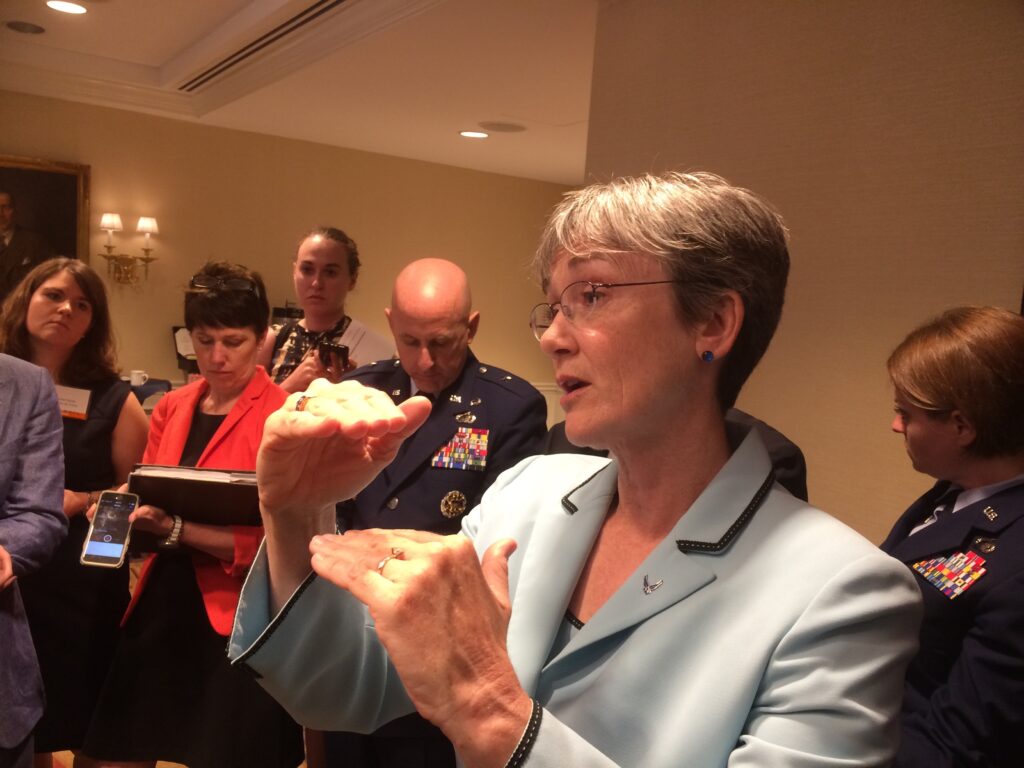
Air Force Secretary Heather Wilson, backed by aides, addresses reporters at the Capitol Hill Club this morning.
CAPITOL HILL: Heather Wilson began her first public speech as Air Force Secretary with a paean to technology, highlighting the service’s history of innovation from the B-29 to the F-117 to the F-35. It would have been an unambiguous signal of administration priorities, except the budget doesn’t really back her up.
Research and development funding is effectively flat, Wilson acknowledged during Q&A. Purchases of the F-35A won’t rise to the desired 60 a year unless Congress accepts last week’s “unfunded requirement” request to add $1.76 billion to the president’s budget. Even this August’s fly-off of candidates for the O/A-X — a low-cost, lower-tech plane for low-threat environments like Afghanistan — remains an “experiment,” not a “procurement,” she emphasized. The only part of the Air Force to get a lot of new hardware in the request for fiscal 2018 is space, which rises $1.5 billion.
Don’t blame Wilson: She just got here. “Having been on the job all of four weeks now, I get to about three o’clock in the afternoon and my head feels like oatmeal,” she told the Capitol Hill Club crowd.
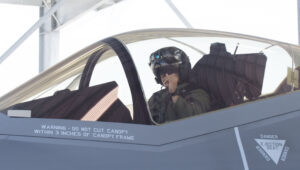
An Air Force pilot, Lt. Col. Chris Pitts, in the cockpit of his F-35A.
Self-deprecation aside, Wilson is the first of President Trump’s service secretary nominees to be confirmed after three withrew their names from consideration. An Air Force officer turned congresswoman, with experience on both the NSC staff and the House intelligence committee, she sailed through the Senate after outsiders Mark Green, Vincent Viola, and Philip Bilden withdrew. Trump has now nominated Richard V. Spencer, a former Marine Corps pilot, for Navy Secretary; there’s no Army Secretary nominee at the moment.
With only a handful of appointees in position, the 2018 budget request was largely driven by the Defense Secretary, Jim Mattis, who unequivocally prioritized near-term readiness — training, spare parts, fuel — over long-term investments — R&D and procurement. Wilson herself made sure to emphasize readiness and associated increases in personnel.
“The first thing is readiness; we’ve got to restore the readiness of the force,” she told a gaggle of reporters when one asked what the Air Force needed to do. “The second is we’ve got to move forward on modernization.”
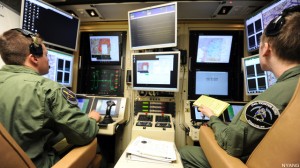
Air Force MQ-9 Reaper operators in training.
In keeping with those priorities, the budget adds 4,100 more active-duty airmen and 1,700 to the Air National Guard & Reserves, primarily in maintenance, pilot training, drone operations, and cyber. It also funds a new bonus system targeted at the most short-handed specialties, especially fighter pilots, where Wilson said “retention is at a crisis level.”
“Morale and readiness go hand in hand,” Wilson emphasized. Pilots who spend most of their time on the ground, waiting for their planes to get repaired, are likely to jump ship for the airlines, where at least they know they’ll fly. To help improve pilot morale, the Air Force is also trying to give them more time flying planes and less time flying desks, with administrative support to handle paperwork, maxed-out funding for flying hours, and nearly maxed-out funding for spare parts and other support.
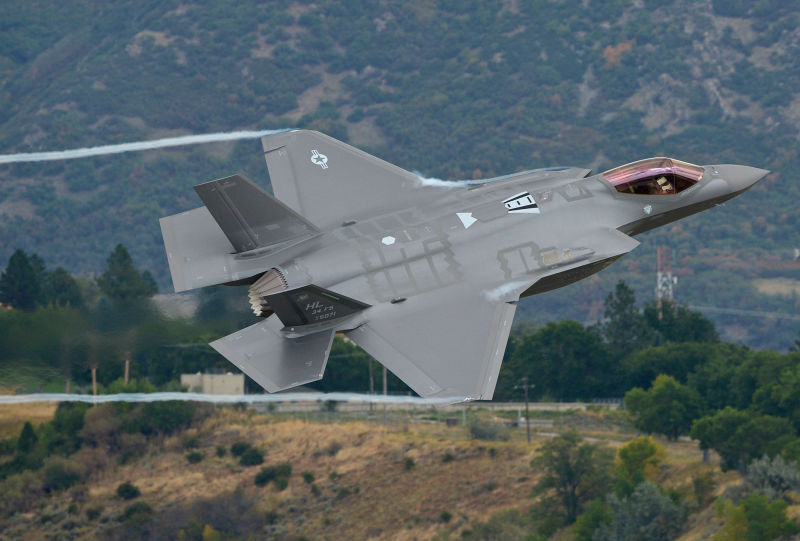
F-35A
Modernization? Maybe
“The reality is we are too small for what the nation expects of us,” Wilson said in her speech. “The fiscal year ’17 appropriations stopped the decline. This proposed budget for fiscal year ’18 starts to restore readiness and modernize the force.”
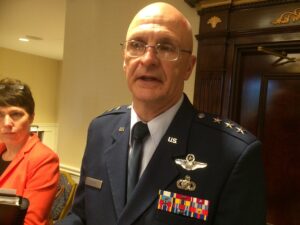
Lt. Gen. Arnold Bunch
Restore readiness, definitely. Modernize? Not so much. The budget includes numerous upgrades for existing aircraft, but that doesn’t stop those planes from aging to unprecedented degrees: Air Force planes now average 27 years old, older than many of their pilots, and the number of new planes bought is too small to keep that average from rising steadily. For new fighters, the service is betting everything on the F-35.
“We only have so much money and so many priorities and so much mission, and we had to prioritize… within the budget that we had,” Lt. Gen. Bunch said. “We do want to get to 60 as quickly as we can.”
Wilson extolled the F-35, likening it to revolutionary past aircraft such as the F-117 stealth fighter and the B-29. The B-29 was the only World War II bomber long-ranged enough to hit mainland Japan, with both incendiaries and atomic bombs, and the most expensive development program of World War II, exceeding even the Manhattan Project. Just as the Air Force stuck with the B-29 through its painful early problems — including several fatal crashes — until it could field the revolutionary weapon, Wilson said, it has stuck with the F-35 despite cost overruns and schedule delays, and it’s now starting to reap the benefits.
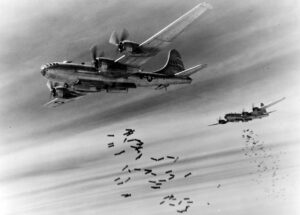
Boeing B-29 bombers raid Burma in World War II
So, I asked her, what’s the next revolution? Wilson’s answer was surprisingly apologetic. “One of the things that we do increase in this budget is (Research, Development, Testing, & Evaluation),” she said, “but…the amount of increase is really more on the test and evaluation end than it is on the R&D end. The actual R&D end is pretty flat and has been for several years.”
That said, Wilson went on, “one of the things that we do kind of foreshadow in this budget is a desire to increase basic and applied research.” (Desire and foreshadowing, while meaningful terms in romance novels, are awfully vague for a budget discussion).
“The other thing that is in the budget at a significant level is future penetrating air defense capabilities,” Wilson said, presumably referring to the Penetrating Counter-Air initiative to develop a next-generation fighter capable of slipping deep into defended airspace, such as the so-called Anti-Access/Area Denial defenses being developed by Russia and China. Overall, Wilson said, “we’ll be looking at a lot of different technologies so we can win the high-end fight long term” — but she’s definitely not going to talk about any details in public.
Subscribe to our newsletter
Promotions, new products and sales. Directly to your inbox.
